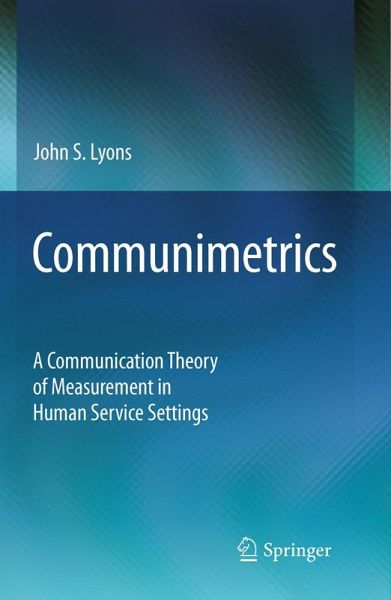
Communimetrics (eBook, PDF)
A Communication Theory of Measurement in Human Service Settings
Versandkostenfrei!
Sofort per Download lieferbar
64,95 €
inkl. MwSt.
Weitere Ausgaben:

PAYBACK Punkte
32 °P sammeln!
Measurement in human services means one thing: how well the effort serves clients. But the data doesn't exist in a vacuum and must be communicated clearly between provider and client, provider and management, and across systems. During the past decade, innovative communimetric measures have helped more than 50,000 professionals worldwide in health care, justice, and business settings deliver findings that enhance communication on all sides. Now, the theory and methods behind this fast-paced innovation are available in this informative volume.Communimetrics presents information in an accessible...
Measurement in human services means one thing: how well the effort serves clients. But the data doesn't exist in a vacuum and must be communicated clearly between provider and client, provider and management, and across systems. During the past decade, innovative communimetric measures have helped more than 50,000 professionals worldwide in health care, justice, and business settings deliver findings that enhance communication on all sides. Now, the theory and methods behind this fast-paced innovation are available in this informative volume.
Communimetrics presents information in an accessible style, and its model of measurement as communication bolsters transparency and ease of interpretation without sacrificing validity or reliability. It conveys a deep appreciation for the unique position of service delivery systems at the intersection between science and management (and between quality and quantity), and shows readers how to create measures that can be used immediately to translate findings into practical action.
This must-have volume offers readers the tools for understanding-and applying-this cutting-edge innovation by providing:
Communimetrics provides a wealth of real-world usesto a wide professional audience, including program evaluators, quality management professionals, enterprise managers, teachers of field research methods, and professionals involved in measurement and management design. It also makes an exceptionally useful text for program evaluation courses.
Communimetrics presents information in an accessible style, and its model of measurement as communication bolsters transparency and ease of interpretation without sacrificing validity or reliability. It conveys a deep appreciation for the unique position of service delivery systems at the intersection between science and management (and between quality and quantity), and shows readers how to create measures that can be used immediately to translate findings into practical action.
This must-have volume offers readers the tools for understanding-and applying-this cutting-edge innovation by providing:
- The theoretical base for communimetrics.
- Practical illustrations comparing communimetrics with traditional methods.
- Guidelines for designing communimetric measures and evaluating their reliability and validity.
- Detailed examples of three widely used communimetric measures-the Child and Adolescent Needs and Strengths (CANS), the INTERMED, and the Entrepreneurial League System Assessment as well as detailed explanations for how they are used and why they work.
- Applications used in a range of settings, including children's services, adult mental health, services for the aging, and business and organizational development.
Communimetrics provides a wealth of real-world usesto a wide professional audience, including program evaluators, quality management professionals, enterprise managers, teachers of field research methods, and professionals involved in measurement and management design. It also makes an exceptionally useful text for program evaluation courses.
Dieser Download kann aus rechtlichen Gründen nur mit Rechnungsadresse in A, B, BG, CY, CZ, D, DK, EW, E, FIN, F, GR, HR, H, IRL, I, LT, L, LR, M, NL, PL, P, R, S, SLO, SK ausgeliefert werden.













